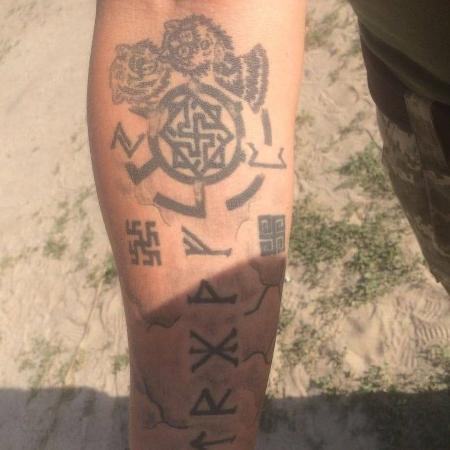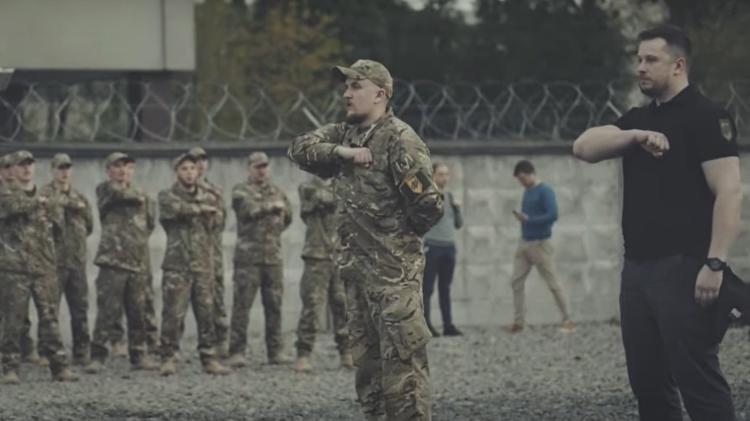Russian President Vladimir Putin attributed the invasion of Ukraine to the goal of “decentralizing” the neighboring country, but eventually counted on the support of troops identified with the far right on the battlefield.
In a survey conducted with the help of researchers, UOL He identified the main units formed by neo-Nazi fighters on both sides of the trench, linked to the Russians and Ukrainians.
Common among these groups are references to Adolf Hitler’s attitudes to Nazi Germany, expressed in symbols or tattoos, to the defense of fascist ideals, to hatred of communism, and to xenophobic attitudes towards ethnic minorities in both countries.
Russia and Ukraine’s relationship with their neo-Nazi ‘allies’

Image: Internet reproduction
In a photograph attributed to a group of allied soldiers of British-origin uniformed Ukrainian troops, a man displays a tattoo on his right forearm with the stylized swastika associated with European neo-Nazi groups.
The war in Ukraine has drawn far-right sympathizers on both sides of the trench. In addition to the volunteers, there are at least six Russian and Ukrainian neo-Nazi regiments in the conflict, which has been going on for more than a month and with no expectation of results.
They are groups that share the same ideals. They are just fighting each other, on opposite sides. War divides the world’s far right”
Leticia Oliveira, researcher
Letícia Oliveira, a researcher and journalist who has researched neo-Nazi groups for more than a decade and runs the “El Coyote” portal, highlights the subtle differences between regiments in the conflict.
“In Ukraine, these groups are linked to the security forces, but they no longer follow the rules. Zelensky [Volodymyr Zelensky, presidente do país]. Russia, on the other hand, treats these groups as ‘destabilizing forces’ and without official intervention, despite working with the military and supporting Putin.
Historian Francisco de Paula Oliveira Fernandes, a graduate of University College Dublin and an expert in research on the performance of the far right in Ukraine, discusses the importance of the political leanings of these groups in times of war.
Neo-Nazis and they commit crimes because they are neo-Nazis. But ideology is secondary. The main motivation of these mercenaries to fight is money and power, not ideals.”
Francisco Fernandes, historian
‘Putin’s army’ against Azov Battalion
This struggle for money and power is rape, execution and torture, described by dissidents as members of “Putin’s private army”.
According to the Pentagon, about 1,000 fighters from the unit have been active in Ukraine’s Donbass region, formed by the breakaway cities of Donetsk and Lugansk, which were declared independent republics by Putin days before the invasion.
According to experts, the Wagner Group also MariupolAccording to the Ukrainian authorities, the southeast of the occupied country is the main target of attacks due to access to the sea and is on the verge of a humanitarian disaster.
“What Russian troops did in Mariupol is a crime against humanity,” he said. Zelensky He talks about the bombing of civilian shelters.
On the other side of the trench, Russian mercenaries face another unit with neo-Nazi ideals and ties to the local government: the Azov Battalion, formed in 2014 by Ukrainian far-right activists to fight separatists. pro-Russian in the process of criminalizing communist and left parties.
Like the Russian mercenaries, the Ukrainian regiment is accused of torture and murder of prisoners of war. “There are such allegations involving Russian and Ukrainian neo-Nazi groups,” says researcher Letícia Oliveira.
Reference to Nazi Germany
The Wagner Group is led by the oligarch Dmitry utkin. A former member of his country’s special forces and close to Putin, he gave the band the nickname it received due to his interest in the work of composer Richard Wagner (1813-1883), part of Nazi Germany and Adolf Hitler’s one-of-a-kind soundtrack. favorite musician.
Geographer and political scientist Tito Lívio barcello Pereira, who has attended study groups on the role of the armed forces in the world, estimates there are at least 6,000 soldiers. Russians Associated with the Wagner Group in the conflict.
Although low compared to the number of armed forces Russians In Ukraine, the expert bets on the effectiveness of the action of more experienced mercenaries compared to the soldiers of the regular troops.
“The veterans of other wars have 15 years of experience in other operations. Since they are experts, they are realizing a new stage in the war in Turkey. Mariupolto hunt members of the Azov Battalion stationed in residential areas”.
Incidentally, the port city, where the headquarters of the Arzov Battalion is located, has been exposed to bomb attacks since the beginning of the war, in which the Wagner Group was involved. Every day, hundreds of civilian vehicles drive to the area to rescue friends and relatives without being sure of their survival.
The Russians still rely on two neo-Nazi groups: the Spartan Battalion and Rusich, which had participated in the fighting in the Donbass in recent years.
Azov: Internal threat to Zelensky
The Azov Battalion, financed by the Ukrainian government itself and included in the National Guard under the command of the Ministry of Internal Affairs, was cited by Russian Foreign Minister Sergei Lavrov to justify the bombing of a maternity hospital in Mariupol on 9 March.
“This hospital has been captured by the Azov Battalion and other radicals,” the Russian minister said.
Still, historian Francisco Fernandes points out that Ukraine’s main neo-Nazi army of about 3,000 soldiers posed a threat to President Zelensky himself.
The Azov Battalion has described Zelensky as a ‘traitor’ since the first day of the war, as he left himself behind in dialogues with NATO. [a aliança militar ocidental]. The ceasefire negotiations failed, in part because of the regime’s pressure on the Ukrainian government.”
Francisco Fernandes, historian
The historian cites the neo-Nazi unit’s affiliation with the Ukrainian government, which has been funding the unit since 2014 to fight separatist groups during the disbanding of the Ukrainian armed forces.
However, it has seen the president leave since 2021, when 11,000 civilians were recruited by the country’s National Guard without the involvement of the regiment, which also provides military training – at the time the government was already under pressure to withdraw from the unit due to the lack of involvement of the regiment. Suspicions of neo-Nazi politics and links to the Azov Battalion’s war crimes charges.
“Azov has threatened to kill the president at least three times since the beginning of the war. Any peace deal must include some form of security for Zelensky. Otherwise, he will be assassinated the next day,” thinks Fernandes.
Political and military ambitions in Ukraine
The Aidar Battalion is referred to by experts as a Ukrainian neo-Nazi regiment of more obscure origin and involved since 2014 in serious war crimes such as bombings in civilian areas, gang rapes and subsequent murders and burial of bodies in mass graves. rape, sex in the Donbass region.
Pravy Sektor is seen as a Ukrainian neo-Nazi unit with larger political ambitions, although it has been involved in armed attacks. However, historian Francisco Fernandes points out that Azov is the most impressive of them.
“Pravy Sector members tried to make the transition to a political movement. Aidar was more discreet. Azov, on the other hand, was more ambitious and prioritized combat power. He was the first to have his own tank column. Example”, compare.

Image: Internet reproduction
Brazil on the neo-Nazi flag
Alex Silva, a Brazilian shooting instructor based in Ukraine, was embroiled in controversy when he was caught at pro-Bolsonaro demonstrations draped in the Pravy Sektor flag in 2020.
He videotaped a tour of the occupied country for seven years, saying he was part of a “small auxiliary police force” supporting Ukrainian forces in the capital, Kiev, in early March. wanted by UOLHe did not respond to messages sent on his cell phone.
In one of the videos he shared on Telegram, Alex Silva talks about the “Ukrainian Brazil” movement, inspired by the violent demonstrations that resulted in the fall of the Ukrainian government in 2014 and attacks on communist politicians. .
“Come and join us. We have a plan A, a plan B… and even a plan C,” he said with a fake wave.
source: Noticias
Mark Jones is a world traveler and journalist for News Rebeat. With a curious mind and a love of adventure, Mark brings a unique perspective to the latest global events and provides in-depth and thought-provoking coverage of the world at large.

